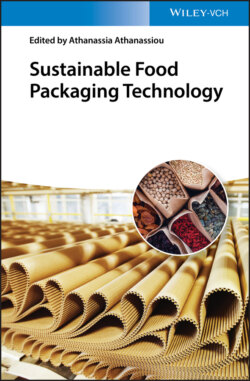Читать книгу Sustainable Food Packaging Technology - Группа авторов - Страница 39
2.3 Chitosan Films and Coatings 2.3.1 Chitin and Chitosan Extraction
ОглавлениеMarine wastes, such as crustaceans' shells and squid pens, can be employed for chitin and chitosan extraction [100]. For this purpose, chemical and/or biological treatments have been employed [101]. Generally, chitin is extracted by a two‐step process, including deproteinization and demineralization [102]. In the case of shell wastes, another step, depigmentation treatment, is required in order to remove color [101]. After extracting chitin, chitosan is obtained by a deacetylation process. Depending on the aggressiveness of the treatment, the deacetylation degree of chitosan may differ, affecting the final properties of the material [103].
In terms of chemical treatments, the deproteinization step is carried out using an alkali solution (usually NaOH), the demineralization process is performed with an acidic solution (typically HCl), and the depigmentation process is accomplished by soaking the chitin in an alkali solution. Subsequently, an alkali solution (commonly NaOH) is used for the chitosan extraction [104, 105]. In the case of biological treatments, instead of chemical substances, bacteria strains are employed for deproteinization and demineralization. For instance, Bacillus subtilis, Pseudomonas aeruginosa, and Serratia marcescens, bacterial strains that produce protease, have been tested for the deproteinization treatment and Lactobacillus plantarum has been analyzed for the demineralization process to remove calcium from chitin [106]. Moreover, for the chitin transformation into chitosan, Rhizopus japonicus, a bacteria strain that processes a high intracellular and extracellular deacetylation mechanism, has been used as a biological alternative [107]. It is worth mentioning that no depigmentation process using bacterial strains has been found.
Although chemical treatments are cheap procedures, appropriate for mass production [108], high concentrations and volumes of acid and alkali solutions are used at high temperatures during chemical treatments and, thus, biological treatments could be more suitable processes from the environmental perspective. Nevertheless, they have longer production times, are more expensive, and have not been implemented for mass production; only pilot scale processes have been reported [107].
A combination of both chemical and biological methods can also be employed. For instance, Pachapur et al. [109] proposed a combined enzymatic deproteinization (with Bacillus licheniformis) followed by a chemical demineralization process, using seawater during all steps of chitin extraction. Thereby, using large amounts of freshwater and chemicals can be avoided. Furthermore, Lopes et al. [110] compared the chitosan extraction by chemical and biological processes at pilot scale and their environmental impact. The use of a soft alkaline treatment, and the possibility of recovery NaOH, water, and fish protein hydrolysates are some of the reported improvements to decrease the environmental impact associated with the chemical treatments. Additionally, some improvements were proposed for the biological processes in order to mitigate the environmental impacts and the costs associated with the enzyme production; in particular, employing crustacean biomass as peptones for bacterial growth could be a strategy to reduce environmental loads.
Recently, a novel method for chitosan extraction has been proposed [111], using microwave technique for all chitosan extraction steps (demineralization, deproteinization and deacetylation). Although the method uses the same preparation conditions as chemical treatments, it needs less time than the conventional one. Indeed, this novel method reduced the deacetylation time from more than 6 hours to less than 30 minutes, reaching the same deacetylation degree. Furthermore, chitosan structure, morphology, and chemical composition in both methods were similar.
